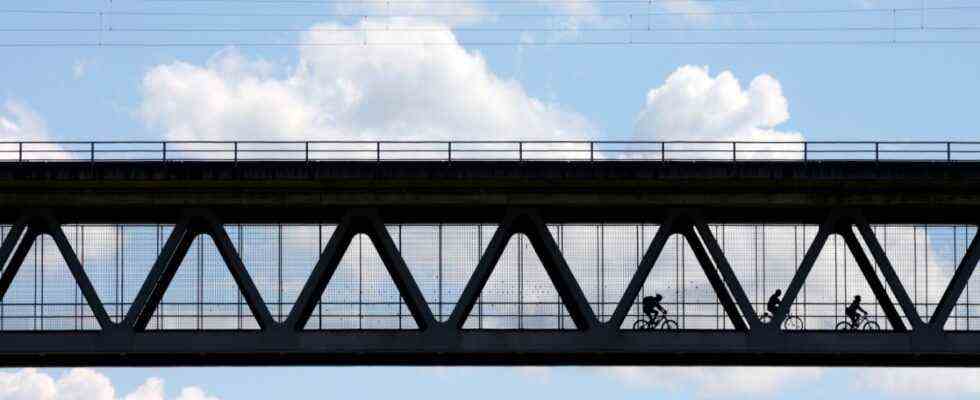The cyclists want another bridge over the Isar, which would connect Grünwald with Pullach. Pedestrians tend to be skeptical and consider the route from Grünwald to Pullach to be too long. This was the result of the needs analysis by the engineering office Schlothauer und Wauer, which their employee Tobias Giehl presented to the municipal council on Tuesday evening. Last summer, the office had an investigation carried out into how many cyclists and pedestrians normally travel between Grünwald and Pullach and the surrounding area. For this purpose, surveys and counts were carried out at the Großhesseloher Bridge and at the Grünwalder Bridge on normal working days in the morning and afternoon, on one day during the Bavarian summer holidays, on two weekend days and on a public holiday between June and October. Of course, the bicycle-friendly weather was also taken into account – slightly cloudy and sunny, no precipitation.
On both bridges, the cyclists were mainly out and about in terms of leisure – on the Großhesseloher around 80 percent, on the Grünwalder 90 percent. On weekdays, however, numerous employees were also spotted on their bikes, namely 52 percent. Many were on their way to work in Harlaching, Solln, Sendling or Giesing. 65 percent of all respondents were regular users of the Grünwalder bridge, 78 percent of the Großhesseloher bridge. From this, the engineers conclude that it is primarily the people who live in the area who move here. Pupils have not been there so far, and errands have very rarely been combined with these bike tours. More people were out and about in the afternoon and evening than in the morning.
According to the surveys, many cyclists make round trips through the district, and many live in the south of Munich. For many, the Grünwalder Bridge is even a kind of goal, namely the turning point. Incidentally, e-bike riders were seen much more often on the Grünwalder Bridge (27 percent) than on the Großhesseloher (16 percent). An important question for people on two-wheelers was, of course, how often they would use a new pedestrian and cyclist bridge over the Isar. 58 percent said they would want to use it regularly.
The new crossing could easily be integrated into the national cycle path network
The engineering office also rated the integration of a new bridge in the supra-municipal cycle path network as good. For many users, it would be advantageous to bypass the Grünwalder Bridge with the help of a new bridge, since the steep inclines make it “more suitable for sporty cyclists”, according to the needs analysis. The new crossing could be built into several existing cycle routes, such as the Munich Radl-Ring or the Via Julia, which runs from Günzburg via Augsburg and Rosenheim to Salzburg. So far, this has led to the Grünwalder Bridge. The M-Waterway from Munich to Lake Tegernsee could also lead across the new crossing, as could the Munich-Venice long-distance cycle route.
The new crossing offers fewer advantages for pedestrians, Giehl reported in the municipal council. Although the first stage of the Way of St. James leads from the Jakobskirche in Munich to Schäftlarn not far away, “a new bridge does not offer any advantage because there are a sufficient number of alternative crossing options of the Isar along the route,” says Giehl. If pedestrians would use the new bridge, then it would probably be mainly to get from Grünwald to Pullach and vice versa. However you would cross the bridge, you could use it to reach important facilities more easily – such as the S-Bahn station, the swimming pool in Pullach and the Josef Breitner Middle School in Pullach. A way to school could be significantly improved here, according to Giehl. Of course, the whole thing also applies the other way around: more Pullachers could get to the Grünwalder Bad in the amusement park more easily. However, the engineers do not expect “a significant potential for increasing everyday foot traffic”. Most would probably get on their bikes.
One local councilor in particular was delighted to note these results: Green Ingrid Reinhart, who first had the idea for this pedestrian and cyclist bridge years ago. Since then, many discussions and feasibility studies have taken place. And there will also be a variety of further investigations to follow. Contact must still be made with many authorities, such as the lower monument protection authority, the immission control authority, the building permit authority and the lower nature conservation authority. In terms of nature conservation in particular, there were already major concerns about the plans, as it would interfere with the landscape too much and many animal species would suffer as a result.

